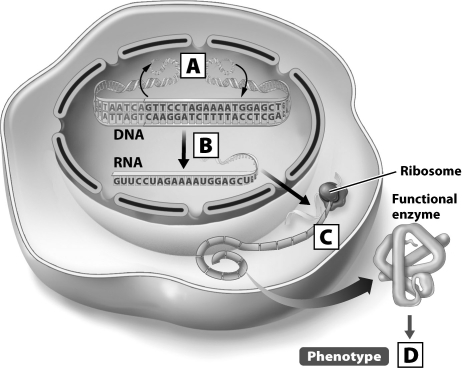Correct Answer

verified
Correct Answer
verified
Short Answer
____________________ DNA consists of stretches of nucleotides that separate genes.
Correct Answer

verified
Correct Answer
verified
Multiple Choice
Replication of DNA cannot begin until
A) phosphate bonds between nucleotides are broken.
B) hydrogen bonds between complementary bases are broken.
C) covalent bonds between sugar molecules are broken.
D) hydrogen bonds between nucleotides in one strand are broken.
Correct Answer

verified
Correct Answer
verified
Multiple Choice
Which of the following are removed from mRNA after transcription?
A) introns
B) transposons
C) spacer DNA
D) exons
Correct Answer

verified
Correct Answer
verified
Multiple Choice
Which of the following is not a base found in DNA?
A) thymine
B) adenine
C) guanine
D) uracil
Correct Answer

verified
Correct Answer
verified
Multiple Choice
The enzymes involved in ATP synthesis in the mitochondria are likely to be encoded by _____ genes.
A) regulatory
B) DNA repair
C) housekeeping
D) transposon
Correct Answer

verified
Correct Answer
verified
Multiple Choice
Most eukaryotic DNA is
A) single-stranded.
B) noncoding.
C) regulatory sequences.
D) prokaryotic.
Correct Answer

verified
Correct Answer
verified
Multiple Choice
Where in this diagram of the flow of genetic information of the cell would translation occur? 
A) A
B) B
C) C
D) D
Correct Answer

verified
Correct Answer
verified
Multiple Choice
Damaged DNA may be repaired by a special class of
A) nucleotides.
B) proteins.
C) deoxyribose molecules.
D) phosphate bonds.
Correct Answer

verified
Correct Answer
verified
True/False
During replication, each "old" DNA strand serves as a template for a new strand.
Correct Answer

verified
Correct Answer
verified
Multiple Choice
Which of the following would not be a required biological property of genetic material?
A) It must be variable.
B) It must exist in paired copies.
C) It must be able to be copied accurately.
D) It must contain the information needed for life.
Correct Answer

verified
Correct Answer
verified
Multiple Choice
Which of the following is directly involved in the regulation of transcription?
A) ribosomes
B) tRNA
C) DNA polymerase
D) repressor protein
Correct Answer

verified
Correct Answer
verified
Multiple Choice
DNA is often damaged or may be replicated incorrectly. Which of the following is not true?
A) Humans do not have DNA repair proteins.
B) A mutation in the gene for a DNA repair protein may make mutations in other genes more common.
C) Certain proteins can repair damaged DNA.
D) The vast majority of DNA damage is fixed.
Correct Answer

verified
Correct Answer
verified
Short Answer
DNA ____________________ results in the copying of a DNA molecule.
Correct Answer

verified
Correct Answer
verified
Multiple Choice
The order of the base pairs in a DNA molecule
A) differs from species to species.
B) is identical in all organisms.
C) is identical in organisms of the same species.
D) differs from cell to cell in a given organism.
Correct Answer

verified
Correct Answer
verified
True/False
The 220 different cell types in the human body each contain all of the same DNA found in every other cell type.
Correct Answer

verified
Correct Answer
verified
True/False
During DNA replication, the template strands of the original DNA molecule are complementary both to each other and to one of the new strands.
Correct Answer

verified
Correct Answer
verified
Multiple Choice
All cells in an organism contain a full copy of that organism's DNA. Your ears do not produce digestive enzymes because
A) stomach cells have extra DNA.
B) ear cells have nonfunctional DNA.
C) some DNA is deleted from cells where it is not needed.
D) different genes are expressed in different parts of an organism.
Correct Answer

verified
Correct Answer
verified
Multiple Choice
The most common way for cells to control gene expression is by controlling
A) translation.
B) transcription.
C) spacer DNA frequency.
D) mutation.
Correct Answer

verified
Correct Answer
verified
Multiple Choice
The sequence of DNA differs among individuals within a species. This is the basis for
A) mutation.
B) protein structure.
C) base pairing.
D) variations in phenotypes.
Correct Answer

verified
Correct Answer
verified
Showing 81 - 100 of 105
Related Exams